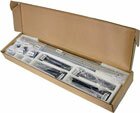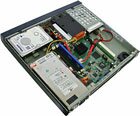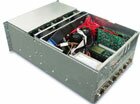Auragan’s software and hardware plug into your existing infrastructure to immediately and dramatically increase the performance of your current network, with no additional media servers, no programming, and no changes to existing content.
You can leverage our appliances and application programming interfaces (“APIs”) for the most flexibility in integrating streaming and digital rights management (“DRM”) with your existing site. We also offer purpose-built plug-ins for both Windows and UNIX web servers such as IIS or Apache.
Locus™ Streaming Acceleration Appliances
The Auragan Locus™ line of appliances helps your existing servers perform better by actively managing the traffic and content delivered from each server.
Traditional load balancers balance traffic either at the network layer based on an indiscriminate amount of network traffic, or at the application layer based on application responsiveness.
Our appliances take both of these into account, while also considering the specific media each server is best able to deliver. This approach optimizes each individual server not just at the network or application layers, but in the O/S itself, resulting in much higher performance.
Thanks to these appliances, Advection.NET is the only fully self-funded and profitable global streaming network.
Locus 3d™ : Global Traffic Balancer
The Locus 3d™ directs users to the closest datacenter based on both network topology and performance.
By default, the appliance works as a DNS server. You host web or media servers around the world, and register your server locations in the appliance. When a user’s DNS server looks up your server name, the Locus 3d™ returns the address of your server closest to them. You may also use it as an HTTP redirector. When the user clicks your URL, the appliance redirects them to the closest server.

The Locus line of appliances shares our standard 1U rackmount chassis
The appliance also provides a web service interface, so you can integrate these lookups with any of your existing site technology. Check user IPs against their credit card addresses to reduce fraud. Target languages or advertising to specific states or countries. You can even hook into the Locus 3d™ from your DRM licensing to support Designated Market Area (“DMA”) codes for television markets.
Our mapping of user IP addresses is remarkably accurate: 99% at the country level, 80% accurate for USA states, and 75% accurate for USA cities. In the USA, we map 75% of IP addresses to within 25 miles of the user’s location. In Belgium, this number hits 80%.
Of course, the Locus 3d™ can also balance based on service availability, total traffic, and optionally on quality of service metrics like latency or packet loss between different datacenters and the user. Other appliances with these capabilities cost ten times as much.
Locus 3s™ : Streaming Cluster Controller
The Locus 3s™ optimizes media storage, propagation, and delivery across clusters of media servers in one or more datacenters. The Locus 3s™ monitors media server usage patterns in real time to proactively manage server traffic and predictively adjust content distribution among available streaming or file download servers. But that’s techno-babble, so here’s what it’s really doing.

The Locus LED keeps you informed at a glance
When you first turn the Locus 3s™ on, you teach it about the servers and storage you already have. You tell it where you put the files when you upload them, and then which servers you’d like to use to serve those files. This way, you don’t have to worry about copying all your files to all your servers in all your data centers. You just put them on one server, or on one storage device, and Locus will help each additional server get the files it needs.
Once the Locus 3s™ knows about your server and storage infrastructure, it begins to monitor the streaming or download traffic to learn about the usage patterns of your users. It keeps track of things like file popularity, how healthy the various servers are in comparison to each other, and how long it takes for files to get from one place to another in your network. The more traffic you have, the more accurate its knowledge gets, and the more difference it makes.

Locus™ appliances ship with mounting and power hardware for easy USA and international deployment
Finally, based on its knowledge of your network, it gets to work to save you money. The appliance behaves like a live system administrator, copying content from storage to servers, or among your servers in various data centers, balancing out your streaming media files or download files across the available resources to use each to its best advantage. When you add new content to your main file location, Locus 3s™ notices the requests for it, and the new content is delivered to the various servers as well.
Because storage, distribution, and delivery are all optimized, you have a cheaper network and fewer servers to manage at any given level of traffic. This means your ROI goes way up. What’s more, the Locus 3s™ doesn’t tie you to a single type of server software or hardware. It manages mixed environments of Windows Media, QuickTime, Real, and Flash on-demand streaming, as well as basic HTTP for software delivery.
Locus 3l™ : DRM License Server
The Locus 3l™ solves the most common concerns of integrating digital rights management into an existing complex hosting infrastructure.

Locus™ internal components are designed for safe shipping and heavy duty service
When you outsource your DRM licensing to a DRM licensing provider but host your own web site, three network paths have to perform flawlessly for the user to receive a playback license. The user surfs your site to purchase content, your site interacts with the DRM provider to authorize a license, and the user has to talk to the DRM provider to receive that license. On the plus side, the DRM provider has developed a robust and redundant licensing infrastructure that’s probably less likely to go offline than your own site. On the minus side, if your own network connection is at all unreliable, you may have problems reaching the DRM provider through their API, and you’ll need to spend a lot of development time to program that API into your site.
Auragan’s Locus 3l™ drops into your own hosting location so you don’t have to worry about network connectivity back to Advection.NET’s DRM licensing infrastructure. Your servers talk to the appliance in real time to create licenses for users on the fly. All of the background data necessary to authorize and issue licenses gets updated asynchronously between the appliance and our DRM back office. So as long as your hosting provider is online, you can issue licenses.
The appliance also offers you the peace of mind to know that even if we sever our relationship, you’ll still be able to support the content you’ve already licensed to users. We essentially put your files’ keys in escrow in the appliance, so if something happens to us, you won’t have to re-license DRM protected content your users have purchased in the past.
Locus 5n™ : Network Attached Storage
The Auragan Locus NAS appliances give you access to the same high performance, low cost network attached storage that we developed for our own network, based on a clustering distributed file system running on a performance tuned version of FreeBSD.
Considering that multi-terabyte storage can cost as much as a small car, we think you owe yourself a walk around the lot to look at what’s available. Our standalone models range from 4TB up to 52TB per chassis, 8 to 26 drives of capacities from 0.5 to 2 TB, and from 1 to 4 dedicated 64-bit storage controllers with on-chip hardware RAID5 acceleration. By special order, we can also build “commodity” storage servers, for file systems handling redundancy through software instead of RAID, and intended for use in racks of heterogeneous high performance commodity storage.

Locus 5n™ 2448 features a blazing 48 terabytes thanks to 24 SATA-II drives
Drop us an email outlining your performance requirements, expected traffic, level of redundancy desired, and the type of services you’ll use the storage for. We’ll propose a set of builds that would work, and discuss the pros and cons of each with you.
In Auragan’s NAS product names, such as “Locus 5n 7200”, the number before the “n” designates how many rack units the model requires, the “n” stands for NAS, and the model number tells the capacity in gigabytes. All of the NAS servers have redundant networking, redundant operating system drives, and dedicated hardware raid controllers.

For reliability, Locus 5n™ uses multilane cabling based on Infiniband specs
When you use online storage to deliver files to your customers, you can’t afford to have performance drop during drive maintenance. Drives will fail. With the best NAS servers, you shouldn’t even notice.
Our Locus NAS servers do not rely on software RAID, software error correction, or software rebuilds after drive failure. All drive tasks are handled by the dedicated storage controllers, freeing up the operating system to interact with your encoding farm or your media servers. Thanks to the on-chip RAID management, these NAS servers can rebuild your data onto a hot spare drive with virtually zero loss in read performance. Amazingly they can serve files while missing a drive almost as fast as when the RAID is error free.
Our NAS models deliver hundreds of terabytes of data every month to millions of users. It's safe to say they’ll handle whatever you throw at them.
Auragan APIs & Software for Servers
Over the past five years we’ve helped dozens of companies integrate our streaming and digital rights management into their web sites. For the most complex sites, we still recommend that our flexible rapid application development team work with your programmers to build the best solution for your future goals. Most sites, however, can get started more quickly by dropping in one of our pre-built web server modules or tying into our powerful application programming interfaces (“APIs”).
Our most popular media server plug-ins enable content owners to control which sites link to their content, with versions for Windows Media Server, IIS, Apache, and QuickTime. Other solutions provide content management, pay-per-minute, or DRM licensing. Each solution is designed to help you earn more from your content.
How to Buy
Auragan’s streaming acceleration appliances and streaming optimized storage appliances are available for sale or lease, either directly or through our partners.
Our custom media server software is available through consultation with Advection.NET sales.
Trademarks and Copyright Information
The appliance designations Locus™, Locus 3s™, Locus 3c™, Locus 3i™, Locus 3n™, and Locus 5n™ are trademarks of Auragan, LLC, and are copyright © Auragan, LLC 2002–2011.
The name Auragan™, the name Advection.NET™, the Auragan “eye of the hurricane” logo, and the Advection.NET “advection wave” logo, are trademarks of Auragan, LLC, and are copyright © Auragan, LLC 2001–2011.






